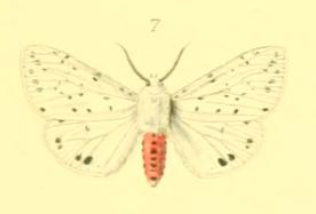
The buff ermine is a moth of the family Erebidae. It is sometimes placed in the genus Spilosoma. The species was first described by Johann Siegfried Hufnagel in 1766. It is found throughout the temperate belt of the Palearctic region south to northern Turkey, Georgia, Kazakhstan, southern Siberia, eastern Mongolia, Amur Region, China, Korea and Japan.

Spilosoma lubricipeda, the white ermine, is a moth of the family Erebidae. It is found throughout the temperate belt of Eurasia from Europe through Kazakhstan and southern Siberia to Amur Region, China, Korea and Japan. In China several sibling species occur.

Spilosoma urticae, the water ermine, is a moth of the family Erebidae. It is found in temperate belt of the Palearctic realm like similar Spilosoma lubricipedum, but prefers drier biotopes. So, S. urticae is more abundant in steppes and it is the single Spilosoma species in Central Asia.

Spilosoma ericsoni is a moth of the family Erebidae. It was described by Georg Semper in 1899. It is found on Borneo.

Spilosoma sagittifera is a species of moth of the family Erebidae. It was described by Frederic Moore in 1888. It is found in India, Nepal, China and Taiwan.

Spilosoma fumida is a species of moth of the family Erebidae. It was described by Alfred Ernest Wileman in 1910. It is found in Taiwan.
Spilosoma daitoensis is a moth in the family Erebidae. It was described by Shōnen Matsumura in 1930. It is found in Taiwan.

Spilosoma erythrozona is a moth in the family Erebidae. It was described by Vincenz Kollar in 1844. It is found in China, eastern Afghanistan and Himalayas.
Spilosoma extrema is a moth in the family Erebidae. It was described by Franz Daniel in 1943. It is found in Yunnan, China.
Spilosoma ningyuenfui is a moth in the family Erebidae. It was described by Franz Daniel in 1943. It is found in China.
Spilosoma pelopea is a moth in the family Erebidae. It was described by Herbert Druce in 1897. It is found in Mexico.

Spilosoma punctaria is a moth in the family Erebidae. It was described by Caspar Stoll in 1782. It is found in the Russian Far East, China, Korea, Taiwan and Japan.
Spilosoma yemenensis is a moth in the family Erebidae. It was described by George Hampson in 1916. It is found in Yemen.

Spilosoma pteridis, the brown tiger moth, is a moth in the family Erebidae. It was described by Henry Edwards in 1875. It is found in the United States in western Oregon and Washington, British Columbia and northern Idaho. The habitat consists of wet forests west of the Cascades, including coastal rainforests, low elevation mixed hardwood-conifer forests, as well as higher elevation conifer forests in the Cascades.
Spilosoma bipartita is a moth in the family Erebidae. It was described by Walter Rothschild in 1933. It is found in Angola, Congo, Kenya, Malawi, South Africa, Tanzania and Zimbabwe.
Spilosoma castelli is a moth in the family Erebidae. It was described by Walter Rothschild in 1933. It is found in Senegal and Nigeria.

Spilosoma dubia, the dubious tiger moth, is a moth in the family Erebidae. It was described by Francis Walker in 1855. It is found from south-eastern Canada west to Alberta and in the eastern United States. The habitat consists of aspen parkland and southern boreal forests.
Spilosoma latipennis, the pink-legged tiger moth, or the red-legged diacrisia, is a moth in the family Erebidae. It was described by Richard Harper Stretch in 1872. It is found in eastern North America, where it has been recorded from Georgia, Indiana, Iowa, Kansas, Kentucky, Maine, Maryland, New Brunswick, New York, North Carolina, Ohio, Ontario, Pennsylvania, South Carolina, West Virginia and Wisconsin.

Spilosoma vestalis, the Vestal tiger-moth, is a moth in the family Erebidae. It was described by Alpheus Spring Packard in 1864. It is found along the coast of western North America, from California north to the Kitsap Peninsula in Washington and western Idaho.
Spilarctia inexpectata is a moth in the family Erebidae. It was described by Walter Rothschild in 1933. It is found in New Ireland in Papua New Guinea.











